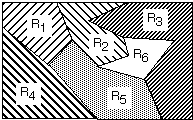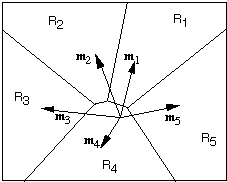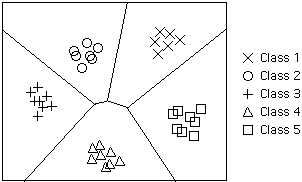

The decision regions are separated by surfaces called the decision
boundaries. These separating surfaces represent points where there
are ties between two or more categories.
For a minimum-distance classifier, the decision boundaries are the points
that are equally distant from two or more of the templates. With a Euclidean
metric, the decision boundary between Region i and Region j is on the line
or plane that is the perpendicular bisector of the line from mi
to mj. Analytically, these linear boundaries
are a consequence of the fact that the discriminant functions are linear.
(With the Mahalanobis metric, the decision boundaries are quadratic surfaces,
such as ellipsoids, paraboloids or hyperboloids.)

How well the classifier works depends upon how closely the input patterns
to be classified resemble the templates. In the example sketched below,
the correspondence is very close, and one can anticipate excellent performance.
However, things are not always this good in practice, and one should understand
the limitations of simple classifiers.
